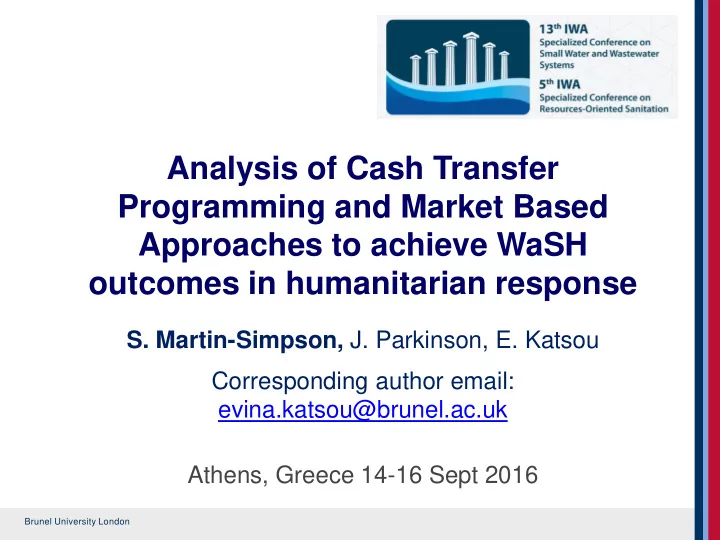

Analysis of Cash Transfer Programming and Market Based Approaches to achieve WaSH outcomes in humanitarian response S. Martin-Simpson, J. Parkinson, E. Katsou Corresponding author email: evina.katsou@brunel.ac.uk Athens, Greece 14-16 Sept 2016 Brunel University London
Presentation Structure Introduction to the research Summary of the research project Research methodology Overview of results and discussion Conclusions and recommendations Brunel University London
Introduction to the Research Brunel University London
The Importance of Water, Sanitation and Hygiene Promotion (WaSH) Diarrhoeal diseases are a major cause of morbidity and mortality in complex emergencies. (Connolly et al, 2004; Waring and Brown, 2005). Result from inadequate quality and quantity of water, substandard and insufficient sanitation facilities, overcrowding, poor hygiene, and scarcity of soap. In camp situations, diarrheal diseases have accounted for more than 40% of these deaths in the acute phase of an emergency (Connolly et al., 2004) Brunel University London
Point of Use Water Treatment Technologies Potentially the most applicable treatment technology during times of emergency (Ray and Jain, 2014). Allows people to treat their own water, rather than rely on water infrastructure and groundwater wells damaged and contaminated by the disaster (Ray and Jain, 2014) User acceptance and training is imperative (Lantagne and Clasen, 2009). Brunel University London
Traditional Humanitarian Response Brunel University London
The Market Based Spectrum: market based relief to market development Source: Oxfam and WFP (2013) Brunel University London
Summary of the Research Project Brunel University London
Aim of the Research What would need to be measured to determine the added value of utilising cash transfers / market based programming (CT/MBP) to achieving WaSH outcomes in humanitarian response? Brunel University London
Research Outcomes 1. Determination of the parameters of ‘added value’ of market based approaches to achieve WASH outcomes; 2. Determination of the indicators required to measure the parameters 3. Application to the case of increasing supply and demand for POU-WTT as part of disaster resilience and post- disaster response Brunel University London
Scope of the Research • Part of a wider 18 month programme being implemented by Oxfam: “Promoting market -based responses to emergencies through WaSH market mapping and analysis” • Haiti, Indonesia, Pakistan and Zimbabwe. Brunel University London
Research Methodology Brunel University London
Determination of the parameters of added value of CTP/MA and associated indicators. Brunel University London
Main Findings Brunel University London
Critical Review and Key Informant Interviews Measurements required at different levels Household Community/ Camp Market Implementing Agency Brunel University London
Critical Review and Key Informant Interviews (2) Source: UNOCHA, 2012 Source: DFID, 2011 Brunel University London
Parameters of the Added Value of CT/MBP PARAMETER DEFINITION Efficiency The cost and time taken to achieve the project outputs. Effectiveness Achievement of objectives, meeting international standard for WaSH. - includes timeliness Appropriateness Tailoring activities to the local need (ALNAP, and Equity 2006). Equity - the effect the CT/MBP approach has on different groups of people. Sustainability Ability of the CT/MBP approach to support longer- term recovery (ALNAP, 2006). 17 Brunel University London
Indicators to measure the parameters of added value of CT/MBP 18 Brunel University London
Application to case of increasing supply and demand of POU-WTT pre and post disaster (1) • The parameters were directly applicable • Established methodologies to collect data against these indicators were appropriate • Multiple indicators were found to be applicable for multiple components of added value 19 Brunel University London
Application to case of increasing supply and demand of POU-WTT pre and post disaster (2) Parameters of Added Value Indicator Efficiency Effective- Appropriateness Sustain- ness & Equity ability Voucher/cash distribution and redemption monitoring - beneficiary and trader Supply Chain Monitoring - blockages and barriers Market Price Monitoring 20 Brunel University London
Conclusions and Recommendations Brunel University London
Conclusions • CT/MBP can support the reduction of faeco-oral disease transmission if applied at household, community and market levels across the whole spectrum of market based response. • CT/MBP parameters strongly correlated to widely accepted criteria for evaluation of humanitarian action – aids user acceptance. • “Menu” of indicators from which the most relevant can be selected. • Application to the case of increasing supply and demand for POU-WTT proved the appropriateness and relevance of the parameters and indicators. Brunel University London
Recommendations • Peer review of parameters and indicators • Pilot the measurement of the parameters of added value of CT/MBP in different humanitarian contexts. • Further define what market strengthening and market development activities look like in practice for WaSH programming 23 Brunel University London
References ALNAP, (2006), Evaluating humanitarian action using the OECD-DAC criteria, An ALNAP guide for humanitarian agencies, Overseas Development Institute, London. Bailey S., and Hedland, K., (2012), The impact of cash transfers on nutrition in emergency and transitional contexts: A review of evidence, Humanitarian Policy Group, Overseas Development Institute, London. Connolly, M.A., Gayer, M., Ryan, M.J., Salama, P., Speigel, P., Heymann, D.L., 2004. Communicable diseases in complex emergencies: impact and challenges. Lancet 364 (9449), 1974e1983. Lantagne, D.S., and Clasen, T., (2009). Point of use water treatment in emergency response. London School of Hygiene and Tropical Medicine, London, UK. Oxfam and WFP (2013), Executive Brief Engaging with markets in humanitarian responses, Oxfam and WFP. [online] Available from: http://www.alnap.org/resource/8975, [Accessed 3rd March 2015] Ray, C., and Jain, R. (2014). Low cost emergency water purification technologies, Integrated Water Security Series, IWA Publishing, Elsevier. Waring, S.C., Brown, B.J., 2005. The threat of communicable diseases following natural disasters: a public health response. Disaster Management & Response 3 (2), 41e47. 24 Brunel University London
Acknowledgments The authors would like to acknowledge: Oxfam GB for providing data and literature for review; the Royal Society for the support of the current research: Ad-Bio: Advanced Biological Wastewater Treatment Processes, Newton Advanced Fellowship- 2015/R2. 25 Brunel University London
Analysis of Cash Transfer Programming and Market Based Approaches to achieve WaSH outcomes in humanitarian response S. Martin-Simpson, J. Parkinson, E. Katsou Corresponding author email: evina.katsou@brunel.ac.uk Athens, Greece 14-16 Sept 2016 Brunel University London
Recommend
More recommend